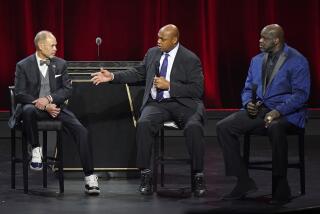Sling TV: High-quality video streams, with some notable trade-offs
Dish Network’s new Sling TV service, which starts rolling out this week, is an unapologetically niche product. If you’re looking for a streaming video service that’s a perfect substitute for cable or satellite TV, Sling TV isn’t it. At this point, nothing is.
What Sling TV does, and does well, is deliver a stripped-down sampling of the pay-TV universe -- the basic package includes only a dozen cable networks, plus an on-demand movie service and some original online programming -- to a TV, laptop or mobile device. I’ve been playing with the service for the last few days, and was pleasantly surprised by the picture quality (with some exceptions) and the nimble user interface.
Full disclosure: I’m one of the small but growing number of Americans who doesn’t subscribe to a pay-TV service. I can pick up all the local broadcast stations with an indoor antenna, and I stream a lot of programs through Netflix and Vudu.
That makes me the target audience for Sling TV, as well as HBO’s forthcoming streaming service. The two offerings aim to fill distinct programming gaps experienced by cord-cutters. For $20 a month, Sling TV offers major sports programming (ESPN, ESPN2 and TNT) and 24-hour news (CNN), among other things; HBO (not yet priced) will provide some in-demand original shows in addition to commercial-free movies.
I tested Sling TV on an Android smartphone and a Roku 3 set-top box connected to my TV set. The service also works on Apple computers and mobile devices, Windows computers, Samsung and LG smart TVs, Amazon and Google set-tops, the XBox One and several other devices. Both versions I tested benefited from a simple, intuitive user interface that made it easy to call up a program guide and jump from channel to channel. On several of the channels -- but not ESPN -- Sling TV offers the ability to pause, rewind, start over and skip ahead through commercials.
The main features missing are the ability to record shows and to program the app to tune to a program when it comes on. The company says it plans to offer more programs on demand, which would compensate for the lack of recording capability. The designers of Sling TV also expect subscribers to combine it with other online services, such as Hulu, that provide on-demand access to programs after they air. What makes Sling unique is that it offers live streams, which Hulu et al. don’t do. That’s a big deal for sports and news, not so much for other types of programming.
Nor does the Sling TV app let users create a specialized program guide populated just by their favorite channels, so that they don’t have to scroll through the ones they’re not likely to watch. Then again, with only about a dozen networks in the basic service, that’s not much of an issue.
The streaming quality on the phone was quite good, provided I had a 3G or 4G connection. When I tuned to a college basketball game on ESPN while riding the train, the picture was pixellated briefly before settling into a crisp image. I had a similar experience with a movie I rented through Sling TV’s on-demand library.
There were no such hiccups when I connected through my Wi-Fi network at home. There, the picture quality was consistently first-rate, whether I was watching a movie or a gymnastics tournament on ESPN2. One disappointment, though, is that I couldn’t stream the Pro Bowl on ESPN to my phone -- viewing was restricted to TV sets and computers. If the smartphone blackouts are routine for major events, that could prove problematic for consumers who like to watch TV on the go.
(Sling says it plans to give subscribers access to ESPN’s WatchESPN mobile app, which may solve the smartphone blackout issue.)
My streaming took a bite out of my data allowance: about half an hour on Sling TV consumed 200 megabytes of data. That translates into 1 gigabyte for every two and a half hours of viewing. That’s a data-cap-busting pace, and subscribers would be well advised to make sure their smartphones are connected to a Wi-Fi network before they start watching a movie.
The movie selection, by the way, wasn’t noticeably different from any of the other major movie-on-demand services’ libraries. The prices, too, were pretty standard -- $3 to $4 for standard definition, $4 to $5 for HD. One clear shortcoming, though, was Sling TV’s lack of a recommendation engine. Nor did it offer a way to download programs so they could be watched later, offline. So much for Sling TV on the plane.
By the way, the service allows only one stream per account at a time. Starting a stream on the smartphone app automatically causes it to pause on the TV, and vice versa.
The picture quality on the Roku box was quite good too. The channels were in full-screen high definition to the extent the programs they carried were, and to my eyes the images were every bit as good as the ones on over-the-air TV. The one exception was ESPN, where the wide-angle shots during the Pro Bowl weren’t always as smooth and sharp as the close-ups.
One other minor complaint: it took a few seconds for the picture to appear when tuning to a new channel, and at times it took a few more seconds for the image to settle into its full glory.
Despite the shortcomings, Sling TV’s channels looked good on devices large and small, and its bare-bones functionality was more than adequate for anyone who doesn’t need to time-shift their shows. In the TiVo era, though, the inability to record one program while you watch another -- or even just to a record a show -- is a pretty big oversight. The sooner Sling includes on-demand access to its programs, the better.
Having said all that, the first consideration for anyone considering Sling TV should be the limited channel line-up. It includes some good specialty channels, such as the Food Network, the Disney Channel and Travel Channel, as well as the more broad offerings of TBS and TNT. Rounding out the basic package are ABC Family, HGTV, Cartoon Network and a “best of online video” channel featuring original programming by Maker Studios. Still, much of today’s great original programming is on cable channels not found on Sling TV.
Then again, signing up for all those channels costs four or five times what Sling TV charges.
Sling also offers two add-on packages for $5 a month each, one with kids’ programming and the other with Bloomberg and three specialty channels. A third, sports-oriented package is coming, the company says.
The service will be available on an invitation-only basis at first, starting Tuesday with the viewers who signed up in advance online. The company will offer a one-week free trial, and a free trial of Sling will also be bundled with as-yet unannounced devices.
Healey writes editorials for The Times. Follow his intermittent Twitter feed: @jcahealey







